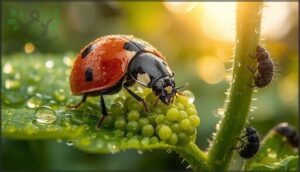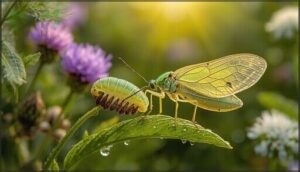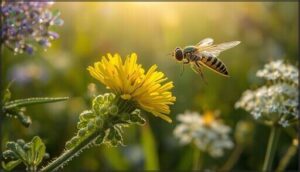This site is supported by our readers. We may earn a commission, at no cost to you, if you purchase through links.
Your garden doesn’t need chemical warfare to stay pest-free—it needs the right allies. Ground beetles alone provide $4.5 billion worth of pest control services annually across North America, patrolling your soil while you sleep. These natural predators, along with ladybugs, lacewings, and parasitic wasps, can handle everything from aphid infestations to mealybug invasions without you lifting a finger.
The secret isn’t complicated pest management systems or expensive treatments. It’s about creating an environment where these beneficial insects want to hang out all summer long. With the right plants, a few habitat tweaks, and some patience with the occasional pest, you’ll build a self-regulating ecosystem that works harder than any spray bottle ever could.
Table Of Contents
Key Takeaways
- Ground beetles, ladybugs, lacewings, and parasitic wasps can eliminate up to 80% of common garden pests naturally, with a single ladybug consuming over 5,000 aphids in its lifetime while providing billions in free pest control services across North America.
- Strategic plant selection—including perennials like Agastache and yarrow, herbs like dill and fennel, and native species—creates overlapping bloom times that attract 35 times more beneficial insects than non-native varieties and reduce pest damage by up to 72%.
- Simple habitat features like shallow water dishes, insect hotels, leaf litter, and brush piles increase beneficial insect populations by 40-60%, while tolerating low pest levels sustains predator presence by 24% without harming yields.
- Delaying spring cleanup until temperatures exceed 50°F, avoiding chemical pesticides, and using botanical alternatives like neem oil when necessary can boost overwintering survival by 40% and slash pesticide use by 95% while maintaining effective natural pest control.
Key Beneficial Insects for Summer Gardens
Your garden is already home to some remarkable allies—you just need to know who they’re. These beneficial insects work around the clock, munching through pests and keeping your plants healthy without any chemicals.
Let’s meet the key players you’ll want to recognize and welcome into your summer garden.
Ladybugs and Their Pest Control Role
Ladybugs are your garden’s tiny pest-control champions. A single adult can devour around 50 aphids daily—that’s over 5,000 in a lifetime. Their appetite for soft-bodied pests makes them indispensable for natural pest control.
Here’s what makes them garden ecology superstars:
- They target aphids, mealybugs, scale insects, and whiteflies
- Their larvae are equally fierce hunters
- They reduce pesticide needs by up to 80% in some gardens
Ladybugs are effective in biological control methods for gardens.
Lacewings and Their Predatory Larvae
While ladybugs often steal the spotlight, lacewings are equally formidable predatory insects in biological control. Their larvae, nicknamed “aphid lions,” possess curved, pinching jaws that make them exceptional natural pest control agents. Each lacewing larva can consume 200 to 400 aphids during its larval development, along with mites, thrips, and small caterpillars.
| Lacewing Life Stage | Diet & Behavior |
|---|---|
| Adult | Feeds on nectar, pollen, honeydew |
| Egg | Laid on thin stalks near prey |
| Larva (Week 1) | Consumes 50–80 aphids |
| Larva (Week 2–3) | Eats up to 120 aphids daily |
| Total Impact | 200–400 pests per lifecycle |
Adult lacewings are recognizable by their delicate, lace-like wings and bright green bodies. They are attracted to gardens with diverse plantings, especially those featuring yarrow, dill, and angelica. To support lacewing habitats and enhance the presence of these beneficial insects, it’s advisable to avoid pesticides and allow nature’s predator-prey balance to thrive. Understanding biological control methods can empower gardeners to create environments that foster these invaluable insects.
Hoverflies as Pollinators and Predators
Hoverflies bring dual benefits to your garden through both pollination services and natural pest control. These beneficial insects visit over 70% of food crops globally, with adults transferring pollen as they feed on nectar.
Their larvae are fierce predators—capable of reducing aphid populations by up to 99% in controlled releases.
You’ll attract these pollinators by planting diverse flowers like yarrow and dill, supporting ecosystem balance through floral attraction.
Parasitic Wasps and Their Garden Benefits
Parasitic wasps represent some of nature’s most effective biological pest control agents in your garden ecosystem. These tiny beneficial insects—many smaller than a period—target aphids, caterpillars, and whiteflies by laying eggs inside pest bodies.
You’ll boost natural pest control by planting buckwheat and purple tansy, which provide nectar that extends wasp lifespan by 40%. Their host-specific parasite control protects pollinators while managing garden pests naturally.
Identifying Other Common Garden Allies
Your garden teams up with several under-the-radar allies that deserve recognition alongside ladybugs, lacewings, and hoverflies. These unsung heroes deliver serious pest control while you sleep or work the soil:
- Ground Beetles patrol nocturnally, providing $4.5 billion in annual pest control services across U.S. gardens
- Soldier Beetles tackle aphids and caterpillars while moonlighting as pollinators during summer peaks
- Spider Allies and praying mantises hunt relentlessly, while Beneficial Nematodes work underground against root pests
Choosing Plants to Attract Beneficial Insects
The right plants can turn your garden into a magnet for beneficial insects. You’ll want to think about bloom times, plant types, and what grows naturally in your area.
Let’s look at the best options to bring these helpful garden allies straight to your doorstep.
Annual Flowers That Support Insect Populations
Annual flowers are your secret weapon for attracting beneficial insects throughout the summer garden. Zinnias with single-layer petals pull in up to 15% more garden allies, while sweet alyssum borders can slash aphid outbreaks by 65%. Marigolds boost pollinator numbers by 29%, and cornflowers support at least five predator groups.
White alyssum outperforms purple varieties by 33%, making flower selection vital for building beneficial habitats rich in pollen sources.
Perennial Blooms for Season-Long Attraction
Perennial flowers transform your summer garden into a year-round haven for beneficial insects. Strategic choices create a continuous buffet that sustains pollinators and predators from spring through fall, strengthening garden ecosystem balance without constant replanting.
Top Perennial Picks for Beneficial Insect Habitats:
- Agastache ‘Blue Fortune’ – Draws nearly 80 bee species and improves pollinator diversity dramatically
- Purple coneflower (Echinacea) – Attracts beneficial wasps and butterflies throughout mid-to-late summer
- Yarrow – Sustains predatory insects with accessible flat-topped blooms
- Black-eyed Susans (Rudbeckia) – Provides essential nectar for multiple beneficial groups
- Catnip and monarda – Extends bloom periods into late summer for continuous resource availability
Research shows perennial flower strip design can boost beneficial insect abundance by 70% compared to non-flowering areas. You’ll see four times more bee species when you choose highly attractive cultivars over less appealing options.
Layering bloom times is your key to seasonal bloom management success. Start with speedwell in late spring, shift to coneflowers mid-summer, then finish with mint and monarda in autumn. This overlapping strategy ensures attracting beneficial insects remains effective throughout your entire growing season.
Native perennial wildflowers deliver the biggest punch for natural pest control. Gardens with diverse perennial strips experience up to 71.7% less pest damage—that’s real protection without chemicals. Each additional native species you plant increases beneficial insect numbers by roughly 4%.
Once established, these perennial powerhouses eliminate annual replanting costs and require minimal maintenance. You’re building a self-sustaining system that gets sturdier each year, sustaining sturdy populations of natural pest controllers while reducing water needs and garden workload.
Herbs and Their Dual Benefits
Herbs pack a double punch you won’t find in typical ornamentals—they feed your kitchen while creating beneficial habitats for garden allies.
Dill, fennel, and oregano attract ladybugs and hoverflies that demolish aphids, while their aromatic oils repel beetles and other troublemakers.
This plant diversity nurtures pollinators like bees through extended flowering periods, giving you natural pest control and fresh flavor in one smart planting strategy.
Native Plant Selection for Local Insects
Native plants outperform introduced species for supporting local insect support and pollinator diversity—studies show they attract up to 35 times more beneficial insects critical for natural pest control.
Native plants attract up to 35 times more beneficial insects than introduced species, making them essential for natural pest control
Your regional planting choices directly influence ecosystem balance, with native flowers hosting richer communities of predators and pollinators than non-natives.
Choose species native to your area for genuine plant diversity that feeds the insects adapted to them over thousands of years.
Creating a Welcoming Habitat
Once you’ve chosen the right plants, your next step is making sure those helpful insects actually want to stick around. Think of it like setting up a cozy bed-and-breakfast—your garden guests need more than just food to thrive.
Let’s look at four key ways you can transform your garden into a haven where beneficial insects will happily call home.
Providing Shelter and Nesting Sites
Think of your garden as a neighborhood—beneficial insects need more than just a good restaurant. You’ll want to set up shelter like insect hotels, nesting boxes, and brush piles where pollinators and predators can safely rest and reproduce.
Leave some leaf litter undisturbed, and keep patches of bare soil open for ground-nesting bees. These simple steps build a thriving insect habitat.
Supplying Water Sources for Insects
Just as beneficial insects need shelter, they also need water to survive those hot summer days. Set up shallow basins filled with clean water and stones for safe landing spots—bees prefer depths under 1.3 cm to avoid drowning.
You can also leave mud puddles as mineral sources for butterflies. Refresh water every few days to prevent mosquito breeding while supporting pollinator hydration and natural pest control.
Maintaining Plant Diversity for Continuous Food
Water brings them in, but plant diversity keeps them around all summer long. Your garden needs overlapping bloom times so nectar and pollen are available from spring through fall—studies show this can boost pollinator visits by up to 70%.
Mix these strategies:
- Early bloomers like willow start the season strong
- Mid-summer standbys such as coneflower bridge gaps
- Late asters extend foraging into autumn
This staggered approach maintains natural pest control when you need it most.
Companion Planting Strategies for Attraction
Beyond variety, strategic pairing supercharges your results. Companion planting strategies work because certain combos actively attract beneficial insects while deterring pests. These beneficial habitats create natural pest control through deliberate plant diversity—especially when companions sit within one meter of crops needing pollinator support and insectary gardens protection.
Marigolds with tomatoes draw parasitic wasps and hoverflies, cutting aphids by 40%. Basil beside tomatoes boosts ladybug numbers by 33%.
| Companion Pair | Beneficial Insects Attracted | Pest Reduction |
|---|---|---|
| Marigolds + Tomatoes | Hoverflies, parasitic wasps | 40% fewer aphids |
| Basil + Tomatoes | Ladybugs, pollinators | 33% better control |
| Nasturtiums + Lettuce | Various predators | 27% less damage |
Natural Pest Control Practices
Once you’ve rolled out the welcome mat for beneficial insects, the next step is keeping them around by ditching practices that work against them.
The good news is that natural pest control isn’t about doing more—it’s often about doing less, and doing it smarter.
Let’s look at some practical ways to manage pests without sabotaging the helpful critters you’ve worked so hard to attract.
Reducing Pesticide Use and Risks
Cutting back on pesticides isn’t just about protecting beneficial insects and pollinators—it’s about keeping your family safe. Integrated Pest Management in gardens can slash pesticide use by 95% while boosting yields.
Eco-Friendly Practices like monitoring pests and using natural pest control mean you’re choosing Pesticide-Free Gardening that promotes Environmental Conservation.
Sustainable Landscaping starts with avoiding chemical pesticides altogether.
Botanical Alternatives for Pest Management
Plant-derived sprays offer a smart middle ground when pests get out of hand. Neem oil and pyrethrins control up to 90% of common garden pests while breaking down in days, not weeks—protecting your beneficial insects and pollinators.
Here’s what works:
- Neem oil disrupts pest feeding and reproduction
- Pyrethrins from chrysanthemums knock down aphids fast
- Essential oils repel without harming natural predators
Reapply every 7–14 days for best results in your organic gardening routine.
Encouraging Existing Beneficial Populations
Sometimes your best allies are already at work. Tolerate a few aphids and soft-bodied pests—they sustain your beneficial insects when times are lean, raising predator presence by 24% without hurting yields.
| Garden Practice | Benefit | Impact |
|---|---|---|
| Leave low pest levels | Sustains ladybugs and lacewings | +24% predator presence |
| Add woody vegetation | Boosts pollinator nesting | +29% bee brood cells |
| Keep plant debris | Provides shelter | +33% beneficial beetles |
| Minimize mowing | Preserves microhabitats | +20% insect abundance |
| Create dense plantings | Increases species richness | +45% biodiversity |
This approach maintains population dynamics and strengthens ecosystem balance naturally.
Monitoring and Managing Pest Outbreaks Naturally
Vigilance makes all the difference. Check your plants weekly for early signs—catching problems when they’re small reduces outbreaks by 30%.
Hand-pick visible pests for an immediate 80% density drop, or blast aphids off with water for 60% clearance.
Pair these moves with botanical sprays like neem oil and biological controls, and you’ll suppress pests by 20% more while protecting pollinators and maintaining ecological balance through sustainable practices.
Maintaining a Balanced Garden Ecosystem
Once you’ve attracted beneficial insects to your garden, the real work is keeping them around for the long haul. A thriving ecosystem isn’t just about planting the right flowers—it’s about creating conditions where pollinators, predators, and plants work together season after season.
Here’s how to maintain that balance and watch your garden flourish with minimal intervention.
Supporting Pollinators Throughout Summer
Think of your summer garden as a pollinator pit stop—without reliable nectar and water, you’re leaving them stranded. Over 75% of flowering plants depend on pollinators, so keep blooms flowing continuously through succession planting.
Refresh shallow water dishes with landing rocks 2–3 times weekly to prevent mosquitoes. This simple combo fosters healthy pollinator populations through scorching heat, strengthening your garden’s ecosystem balance and natural pest control all season long.
Promoting Biodiversity for Long-Term Health
You’re building more than a pretty space—you’re fostering ecosystem resilience that pays off for years.
Biodiverse gardens show up to 12% higher species richness, strengthening soil health and slashing pest problems naturally. Plant diversity creates ecological balance where beneficial insects thrive, slashing your need for chemical interventions by up to 80%.
That’s garden sustainability in action, and it starts with promoting biodiversity through intentional plant choices.
Garden Maintenance Tips for Beneficial Insects
Healthy maintenance routines shape your garden ecosystem without disrupting beneficial insects. Seasonal Cleanup timing matters most—delay spring tidying until temperatures consistently top 50°F, boosting overwintering survival by 40%. Mulch Benefits extend beyond moisture; straw cover increases ground beetles by 60% while supporting natural pest control through stable Soil Temperature Management.
- Leave standing stems and “weedy” margins for Insect Shelter and nesting
- Keep leaf litter in place to protect lacewing larvae through winter
- Preserve logs and brush piles to triple overwintering success rates
Your garden’s Ecosystem Balance depends on thoughtful care that honors the pollinators and predators working alongside you in summer garden care.
Measuring Success in Natural Pest Control
Track your garden’s health with simple observations that reveal real progress. Pest Reduction Metrics show success when aphid numbers drop by 22% within weeks of attracting beneficial insects.
Watch for a 25–35% Crop Yield Analysis improvement as pollinators boost production.
Sustainability Indicators like fewer pesticide applications—often reduced by 32%—confirm your ecosystem balance is working alongside biological control agents.
Frequently Asked Questions (FAQs)
What mulches work best for beneficial insects?
Wood chips create the best refuge for beneficial insects, offering cool, moist shelter for predatory beetles and spiders.
Living mulches between rows support natural pest control too, while reflective plastic mulches repel pests but don’t harbor helpful predators.
Can beneficial insects survive extreme summer heat?
While you might worry the heat will wipe them out, beneficial insects show surprising thermal tolerance. Most survive moderate warmth, but extreme temperatures above 30°C can reduce survival rates and natural pest control effectiveness markedly.
How long until beneficial insects colonize gardens?
You’ll usually see beneficial insects colonize new garden habitats within one to three months. Ladybugs start laying eggs within three to ten days, while hoverflies and parasitic wasps establish populations throughout your first growing season.
Do beneficial insects need supplemental feeding options?
Like bees stocking honey for winter, your garden’s beneficial insects thrive when you provide supplemental feeding options.
Nectar sources and pollen provision support pollinators and natural pest control allies, boosting their survival and effectiveness year-round.
Which beneficial insects work well together naturally?
Predator guilds form when ladybugs, lacewings, and hoverflies hunt aphids on the same plants without competing. These beneficial alliances create ecological balance through natural partnerships.
Foliage hunters work alongside ground beetles, while parasitic wasps complement other predators for effective natural pest control.
Conclusion
Your garden’s workforce doesn’t require a paycheck—just the right invitation. By attracting beneficial insects to your summer garden through thoughtful plant selection and habitat creation, you’re fundamentally hiring a 24/7 security team that never clocks out.
The ground beetles, lacewings, and parasitic wasps will handle the dirty work while you enjoy the harvest. Give them what they need now, and they’ll transform your garden into a self-defending paradise that thrives without constant intervention.
- https://sites.dartmouth.edu/dujs/2024/07/19/the-role-of-pollinator-gardens-in-urban-ecosystems-combating-pollinator-decline-through-strategic-planting-and-public-awareness/
- https://ocean.njaes.rutgers.edu/wp-content/uploads/2025/03/6-FS295-Benificial-Insects-Rutgers-SD-2023.pdf
- https://xerces.org/sites/default/files/2018-05/16-020_01_XercesSoc_Habitat-Planning-for-Beneficial-Insects_web.pdf
- https://www.proterrapc.com/blog/2024/april/attract-beneficial-insects-for-pest-control/
- https://hort.extension.wisc.edu/articles/plant-flowers-to-encourage-beneficial-insects/













